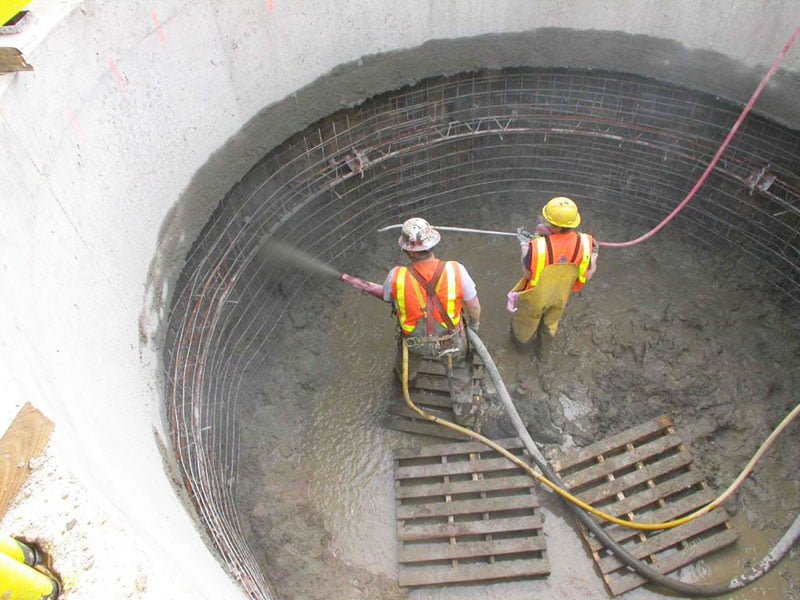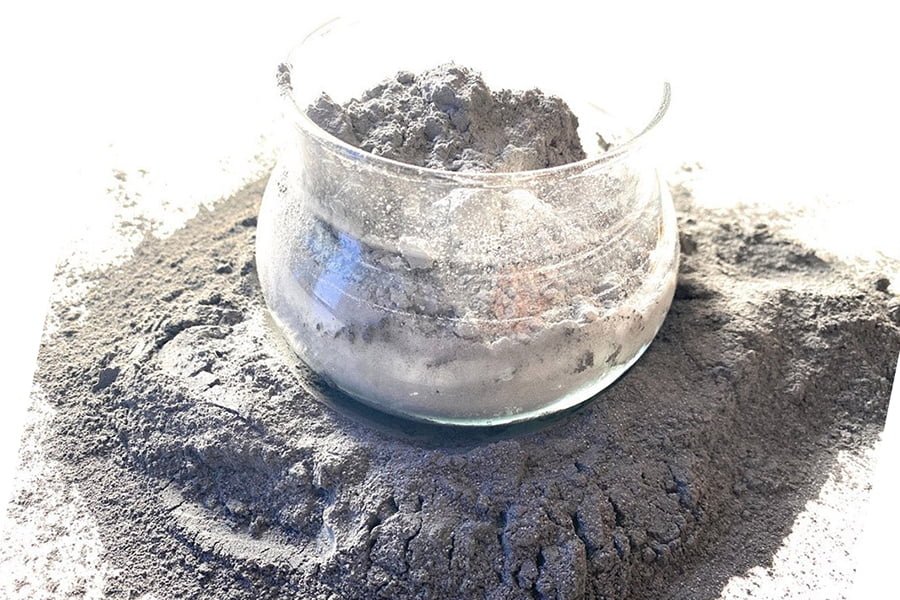INTRODUCTION
The use of pozzolanic materials is an old as that of the art of concrete construction. It was recognized long time age, that the suitable pozzolona used in appropriate amount, modify certain properties of fresh and hardened mortars and concretes.
It has been amply demonstrated that the best pozzolona in optimum proportions mixed with Portland cement improves many qualities of concrete, such as:
– Lower the heat of hydration and thermal shrinkage ;
– Increase the water tightness;
– Reduce the alkali- aggregate reaction;
– Improve resistance to attack by sulphate soils and sea water;
– Improve workability;
– Lower costs.
Pozzolanic materials are siliceous or siliceous and aluminous materials, which in themselves possess little or no cementitious value, but will, in finely divided form and in the presence of moisture, chemically react with calcium hydroxide liberated on hydration, at ordinary temperature, to form compounds, possessing cementitious properties.
BACKGROUND OF SILICA FUME
Silica fume is a by-product from electric arc furnaces used in the manufacture of silicon metal of silicon alloys. The material, which contains more than 80% silica in the form of extremely fine particles (0.1 m average diameter). When used to produce high-performance concrete, silica fume is typically 4-15% of the cement weight. The exact addition rate depends on the specific performance characteristic to be improved. Compared to the other ingredients in concrete, the amount of silica used is small.
For the silica fume to be effective, there are two issues that must be known:
– First, the agglomerations that make up the densified silica must be broken down.
– Second the silica fume must be distributed uniformly throughout the concrete.
MAKING SILICA FUME CONCRETE IN THE LABORATORY
Silica fume must always be added with the coarse aggregate and some of the Water. Never batch the silica fume alone or first into the mixer. Mix these materials for 11/2 minutes. Add the Portland cement and any other cementitious material such as fly ash or slag cement. Mix for an additional 11/2 minutes.
Add the fine aggregate and use the remaining water to wash in any chemical admixtures. Mix for 5 minutes, rest for 3 minutes, and mix for 5 minutes. Actual time of mixing may vary, depending upon the characteristics of mixer. If full dispersion and efficient mixing has been accomplished, mix longer.
WORKING OF SILICA FUME
Silica fume works on chemical reaction called the “pozzolanic” reaction. The hydration (mixing with water) of Portland cement produces many compounds, including calcium silicate hydrates (CSH) and calcium hydroxide (CH). The CSH gel is known to be the source of strength in concrete. When silica fume is added to fresh concrete it chemically reacts with the CH to produces additional CSH. The benefit of this reaction is twofold; increased compressive strength and chemical resistance. The bond between the concrete paste and the coarse aggregate, in the crucial interfacial zone, is greatly increased, resulting in compressive strengths that can exceed 1046 Kg/cm2. The additional CSH produced by silica fume is more resistant to attack from aggressive chemicals then the weaker CH.
CHEMICAL COMPOSITION OF SILICA FUME
Chemical composition of silica fume will mostly depend upon composition of the principle product being made by furnace additionally, the composition is also influenced by the furnace design; generally a furnace with a heat recovery system produces silica fume with lower ignition loss. The sio2 content of silica fume varies with the silica content of alloy being producer. Unlike other by product pozzolona such as fly ash, silica fume from a single source is little or no variation in chemical composition from one day to another,
Item Requirement (%)
SiO2 96
Al2O3 0.70
Fe2O3 0.28
CaO 0.30
MgO 0.50
K2O 0.80
Na2O 0.26
PHYSICAL CHARACTERISTIC
The specific gravity of calcium silicate fluoride (CSF) from silicon metal of ferrosilicon alloy industries is close to that of amorphous silica that is approximately 2.2
The amorphous silica structure and the fine particle size are the principle reasons for the excellent pozzolanic activity of CSF, the surface area by Blaine s air permeability method ranged from about 3.3 to 7.7 m2 / g. The spherical shape of CSF can be confirmed by scanning electron microscopy of well- dispersed particles. Generally, the particles exist in the form of agglomerates.
Scanning Electron Micrograph of silica fume particles.
PROPERTIES OF FRESH CONCRETE USING SILICA FUME
Workability
Water demand increases in proportion to the amt of silica fume added. The increase in water demand of concrete containing silica fume is about 1% for every 1% cement substituted Workability is the ease with which a concrete mix can be handled. Water measures can be taken to avoid this increase by adjusting aggregate grading and use of super plasticizer. The addition of silica fume will lead to a cohesive mix due to more solid-to-solid contact and will have a lower slump. This reduces bleeding and segregation.
Bleeding and segregation
The effect of silica fume on the rheology of fresh concrete is considered a stabilizing affect in the sense that addition of fine particle to a concrete mix tends to reduce segregation and bleeding. When very fine particles of silica fume are added to concrete the size of flow channel is greatly reduced because these particle are able to find their way into empty spaces between 2 cement grains causing drastic segmentation of bleed water flow and reduce bleeding. Due to increase in the number of solid-to-solid contact, the cohesiveness of the concrete mix is greatly improved when silica fume is added. This makes the concrete highly attractive for pumping, shotcreting as it reduces segregation.
Plastic Shrinkage
Loss of water by evaporation from the surface of concrete or by absorption by aggregate or sub grade is believed to be the reasons of plastic shrinkage, due to which cracks may appear at the surface. Since concrete containing CSF shows little or no bleeding, there are several reports confirming the sensitivity of this concrete to plastic- shrinkage, cracking when exposed to drying conditions at early age. In order to overcome this problem, the surface of concrete must be protected against evaporation as soon as possible after placement. This precaution is a part of the standard concrete curing practice in hot weather.
Properties of hardened silica fume concrete
Creep
Creep of concrete is inversely proportional to strength. Since CSF is a highly pozzolanic material, it is expected that the creep of concrete containing CSF will be lower than the corresponding Portland cement concrete a reference concrete made of a calcareous aggregate and normal Portland cement, and a concrete made of the same amount of the aggregate but with 25% (by weight) cement replaced by CSF. The ratio between water to cementations material was 0.435
Examination of the 1- year creep data showed that basic creep strains were similar in both the cases: however, the drying creep strain was about 370 X 10-6 for the reference concrete compared to 300 X 10-6 for the CSF concrete.
Strength characteristic
If CSF is used as an addition, there is no deleterious effect on early strengths (i.e. I- day and 3 day strengths), and a noticeable strength increase is recorded during the 3 to 28 days moist- curing period 30 when most of the pozzolanic reaction takes place. Consequently, the relative strength increase during the 28 to 90 – day period is relatively low. From the results of the investigation reported the addition of 24 kg/m3 CSF to the concrete mixture containing 297 kg/m3 ASTM Type I Portland cement caused a strength increase of about 10% and 20% at 7 and 28 days, respectively; there were no differences in the strength of reference concrete and the CSF – concrete at the test ages I and 2 days.
Three series of both non air- entrained and air- entrained concrete mixtures were designed. The first contained 284kg / m3 of ASTM Type I Portland cement 0.6 ratio between water to cementations materials (i.e., Portland cement + CSF), and 0.5, 10, and 15 % cement replacement replacement by weight with CSF (94 % SiO2, 20 m2/g surface area) The second contained 340kg/m3 Portland cement 0.5 ratio between water to cementations materials, and similar levels of cement replacement with CSF as the first series. The third contained 431 kg /m3 Portland cement, 0.4 ratios between water to cementations materials.
The incorporation of CSF did not result in a significant change in compressive strength at 3 days with concretes of 0.6 and 0.5 ratio of water/ (cement+ CSF); however, the concrete with 0.4 ratio of water / (cement + CSF); showed increase in strength with increasing amount of the fume used in the test (i.e. 5 to 15 % cement replacement)
Regardless of water / (cement + CSF) ratio at 7 days and 28 days the compressive strength of concrete were increased.
All air- entrained concretes, both with and without: CSF, showed strength loss when compared with the corresponding non- air entrained concrete.



